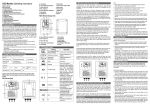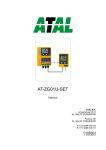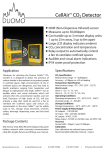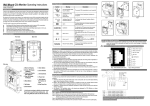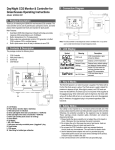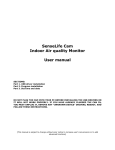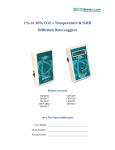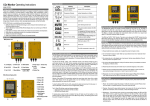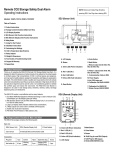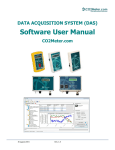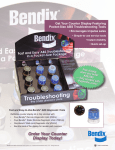Download CO2 Monitor Operating Instructions
Transcript
CO2 Monitor Operating Instructions Model: RAD-0100 A. LCD display B. Yellow LED (Fault indicator) C. Red LED (Alarm 2) D. Red LED (Alarm 1) E. Green LED (Power) F. Reset Button G. Mode Button Doc Rev 7/2012 Table of Contents 1. Product Overview 2. Package Contents Check & Main Unit View 3. LCD Display Symbols 4. SEU (Sensor Unit) Instructions 5. RDU (Remote Display Unit) Instructions 6. Safety Notes 7. Caring for Your Product 8. Installation Instructions 9. Customizing the Factory Default Settings 10. Specifications 11. Weight & Dimensions 12. Fault Codes & Troubleshooting Guide H. Enter Button I. Communication Cable to RDU J. Relay Output K. Power Supply L. Rubber Cap M. Ambient Air Entry Vents N. Buzzer RDU (Remote Display Unit Model RAD-0101) 1. Product Overview Thank you for selecting the RAD-0100 CO2 Monitor. It is designed to detect the presence of carbon dioxide in ambient air to protect people in confined spaces. High concentrations of CO2 in confined spaces are dangerous, and may lead to health problems ranging from headaches and fatigue to asphyxiation and death. The RAD-0100 CO2 Monitor includes an audible alarm and visual indicator which will activate when CO2 concentration reaches a user-defined pre-set level. Detection of high levels of CO2 will also activate a relay that can be used for a fan to ventilate the confined space and reduce CO2 concentration in the area. This makes the RAD-0100 CO2 Monitor useful in in CO2 storage areas, breweries, wineries, cellars, beverage dispensing areas, restaurants or fast food outlets. Features: 1. NDIR (Non-Dispersive Infrared) technology is used to measure CO2 concentration up to 50,000 ppm (parts per million). 2. SEU (Sensor Unit) can connect with up to 3 RDU (Remote Display Units) to allow warnings at multiple locations. 3. Large digital LCD display clearly indicates the ambient CO2 concentration and temperature. 4. Relay output can automatically control a fan to ventilate confined spaces. 5. Audible and visual alarm indications. 6. IP54 Water Proof Protection of SEU (Sensor Unit) except backside when installed on the wall. 2. Package Contents Check & Main Unit View RDU (Remote Display Unit) Q. Red LED (Alarm 2) R. Yellow LED (Fault Indicator) S. LCD Display T. Enter Button U. Mode Button V. RJ45 Plug for additional RDUs (Output) W. RJ45 Plug for SEU (Input) X. Buzzer 3. LCD Display Symbols Symbol Meaning CO2 Concentration ppm (Parts Per Million) 7 meter communication cable Panel holders User manual Diagnose Accessories: Plug lock 1 pc Screw 10pcs Nail cable clip 10 pcs Warning paper 1 pc Expansion plug 10 pcs Caution: Move the rubber cap from position “M” to position “L” when RAD-0100 is first removed from the packaging so that the vent is not blocked while the RAD-0100 is working. SEU (Sensor Unit) Ambient CO2 concentration Ambient temperature in Celsius Ambient temperature in Temperature (Fahrenheit) Fahrenheit Alarm Network cable connector Description Temperature (Celsius) The RAD-0100 package comprises the following parts: Main Unit: SEU( Sensor Unit) O. Green LED (Power) P. Red LED (Alarm 1) First Alarm level Second Alarm level Calibration Recover Factory Setting ESC Hi 4. SEU (Sensor Unit) Instructions 6. Safety Notes The SEU should be placed in a room where CO2 is likely to accumulate, or is stored, such as a closet with CO2 canisters. With power, the green OK LED will turn on and the LCD will immediately display the ambient CO2 concentration and temperature. Your safety is very important. To ensure you use the product correctly and safely, please read these warnings and this User Manual before using the RAD-0100. Otherwise, the protection provided by the equipment may be impaired. These warnings provide important safety information and should be observed at all times. The SEU has DIAG, FLT AL1, AL2, CALI and ReFactSet functions. The DIAG function executes communication tests between the SEU and RDU. Calibrate the SEU under CALI mode when necessary. If data-setting is done incorrectly, use the ReFactSet to return to the original factory setting. There are two alarm levels. Each level is adjustable. AL1 can be set to 0.5%, 1%, 1.5% or 2% CO2. By default, AL1 is set to 1.5% (15,000ppm). AL2 can be set to 1.5%, 2%, 2.5%, 3%, 3.5%, or 4% CO2. By default, AL2 is set to 3% (30,000ppm). When the SEU detects CO2 levels that exceed the first alarm level, the red AL1 LED will blink, the buzzer will sound intermittently, and the relay will be triggered. When CO2 levels drop below the first alarm level, the LED and buzzer will stop, and the relay will return to the normal open state. If the concentration of CO2 continues to rise above the second alarm level, the AL1 and AL2 red LED’s will flash together, and the tempo of the buzzer will increase. Once triggered, the AL2 alarm will remain until the Reset Button on the SEU is pressed or AC power is removed. Warning: Once the ambient CO2 concentration rises above the second alarm level, a safety notice “ESC” will be continuously displayed on both the SEU and RDU LCDs. YOU MUST ventilate the space and/or wear an oxygen mask before entering the room where the SEU is placed. To clear the flashing ESC from the LCD, press the Reset button or unplug the AC adapter. If the communication cable between the SEU & RDU are not properly connected or are loose, the fault FLT LED will blink. To fix this, re-insert the cable on both ends. If the cable is accidentally inserted into the output port on the RDU, after ºC/ ºF flashes for one minute, the “Er7” message will flash on LCD. Unplug the cable from the output port and plug it into the Input port. The unit will work normally after corrective action. If cleaning places where the SEU is installed, remove the rubber cap from the storage position and place it over the ambient air vents as shown below. Water will not enter into the SEU during cleaning. Failure to seal the ambient air vents from water may renter the SEU CO2 sensor inoperable. After cleaning, be sure to return the rubber cap to the storage position. 2. Do not place the unit or the adaptor near a heat source. Heat can cause distortion of the unit, which may result in an explosion or fire. 3. Do not touch the exposed electronic circuitry of any device under any circumstances, as there is the danger of electric shocks. 4. Only use the included power adaptor. Improper power adaptor or power sources can cause serious damage to the product, resulting in injury or death to the user. 5. When first installing the unit, use the “DIAG” function to verify the communication between SEU and RDU. 6. Make sure that the power adaptor is tightly mounted using the plug lock so that the power adapter cannot be easily or accidentally disconnected. 7. NEVER enter a room if the safety notice ESC is displayed on the LCD of either the SEU & RDU. Careful and protective action must be taken before entering the room where the SEU is installed. 8. Ensure that external power is supplied to the ventilation fan while the relay is closed. If there is no power to the fan, the relay will not work. 7. Caring For Your Product 1. Repair - Do not attempt to repair the product or modify the circuitry by yourself. Please contact your local dealer or a qualified repairman if the product needs servicing. 2. Cleaning - Disconnect the power before cleaning. Use a damp cloth. Do not use liquid cleaning agents such as benzene, thinner or aerosols, as these will damage the device. 3. Maintenance – We recommend users to test the communication between the SEU and RDU under ‘DIAG” function to verify the working conditions for the SEU and RDU. If the four LED’s blink and the buzzer of SEU and RDU sound simultaneously, it indicates that SEU and RDU work normally. When the LCD displays a safety icon “ESC”, please take immediate protective action to check if CO2 leakage has occurred. We suggest users to do the calibration and thorough function check once within two year to make sure that the RAD-0100 CO2 Monitor is working properly. 8. Installation Instructions Alarm icon Test communications between the SEU and RDU The relay will be triggered when CO2 concentration exceeds the first alarm level, the Red 1 LED will flash, and buzzer will sound Safety Notice “ESC” displays on LCD when CO2 concentration exceeds the second alarm level. The Red 1 and Red 2 LEDs will flash, and buzzer will sound Calibration mode - when the accuracy deviates from the actual CO2 concentration. Recover factory default settings. This cancels all customized settings. Indicates the CO2 leakage once the CO2 level is above the second alarm level The CO2 concentration is above 5% (50,000ppm). 1. Handle the device carefully; do not subject the product to impact or shock. Please carefully take out the SEU (Sensor Unit), RDU (Remote Display Unit), panel holders, network cable connector, 7 meter communication cable, plug lock, screws, expansion plugs, nail cable clips, and warning paper from the package. 5. RDU (Remote Display Unit) Instructions The RDU (Remote Display Unit) should be placed outside the room where CO2 is stored or used. The RDU is connected to the SEU with a wire that has a maximum length of 25 feet. The RDU should be placed where it can be conveniently observed before entering the room where the SEU is located. The RDU is a repeater, and displays the measurements made by the SEU on an easy-to-read digital LCD along with important safety information. The AL1, AL2, OK and FLT LEDs function the same on both the SEU and RDU. Make sure the cable from SEU is connected into the INPUT port of the RDU. The RDU has a DIAG function to test the communication between the SEU and RDU. However, you can only reset the RAD-0100 CO2 Monitor from the SEU. Step-by-Step Installation: 1. Choose a suitable location to install the SEU. Fix the panel holder on the wall with the four screws (included); the recommend installation height is about 0.45 meters (1.5 feet) from floor and close to the manifolds and valves as possible. 2. Put the SEU on the panel holder, making sure that they are connected tightly. 3. Fix a second panel holder in a suitable location outside the monitored space with screws (included). Push the RDU onto the panel holder, and stick the warning paper next to the RDU. Repeat this step for up to 3 total RDU units. 4. The communication cable is pre-wired to the SEU. Route the cable to the first RDU and fixed the communication cable to the wall by nail cable clips. Then plug the cable into the INPUT port on the RDU. Daisy chain cables from the RDU to any additional RDUs. 5. The RAD-0100 CO2 Monitor has one relay output. The relay cable is pre-wired to the SEU. The relay can control a fan or blower to ventilate the monitored space when necessary. The relay will be triggered when the CO2 concentration exceeds the first alarm level. 6. After finishing the installation, plug the AC power adapter into a standard 120VAC electrical supply outlet. 7. Mount the Plug lock by expansion plugs so that the power adapter cannot be disconnected without use of mechanical tools. 8. When the power is connected, The SEU and the RDU will immediately begin to work. Use the “DIAG“ function to verify communication between SEU and RDU. The four LED’s will blink and the buzzer will sound on both the SEU & RDU. After that the communication is verified. Test this by verifying that the display is the same on both the SEU & RDU. RDU (Remote Display Unit) 10. Specifications Mounting the plug lock: Customizing the Second Alarm: 1. Press Mode until the AL2 icon flashes 2. Press Enter. The AL2 icon will show on the LCD 3. Press Mode to step through 1.5%,2%,2.5%,3%,3.5%,4% alarm levels 4. Press Enter again to store the new AL2 alarm level. 9. Customizing the Factory Default Settings When power is connected, the SEU and RDU will immediately begin to monitor the CO2 concentration and the temperature. While the factory default settings will work for most users, you can also customize several parameters as necessary. Note: The second alarm level should be higher than the first alarm level when setting with the alarm level parameter. Using the Calibration Function: Temperature ºC/ºF: 1. Press Enter to switch between ºC and ºF temperature Using the Diagnostic Function: 1. Press Mode until the DIAG icon flashes 2. Press Enter. The four LED’s will blink on the SEU and the buzzer will sound 3. The four LED’s will blink and buzzer will sound simultaneously on the RDU 1. Press Mode until the CALI icon flashes 2. Press Enter. The CALI icon will show on the LCD 3. Press and hold Mode for at least 10 seconds. The CALIBRATING icon will flash. Calibration is done automatically. After 10 minutes the LCD will display “Pass” or “Fail”. 4. If the LCD displays “Pass” press ENTER. Calibration is complete. If it displays “FAIL” repeat the process. How to Calibrate - The SEU should be calibrated at least once a year, or after an alarm, using normal, outdoor air (approximately 400ppm). If you KNOW the room is filled with fresh air, you can calibrate the SEU in-place. Otherwise you should move the SEU and power supply outdoors and calibrate. Do not breathe toward to SEU during the calibration process, as your breath’s CO2 will affect the calibration settings. CO2 & Temperature specification: CO2 Specification Measurement Range 0 - 50,000 ppm (5%) display Display Resolution 10 ppm ±100 ppm or ±5% of reading, whichever is Accuracy greater Repeatability ±20 ppm @400 ppm Annual Drift <20 ppm/Year@400ppm Temperature ±0.2% of reading per °C or ±2 ppm per °C, Dependence whichever is greater, referenced to 25°C Pressure Dependence 0.13% of reading per mm Hg <60 seconds for 90% response to step Response Time change AL1 (First Alarm Level) 0.5 / 1 / 1.5 / 2 % , Default AL1= 1.5% AL2 (Second Alarm Level) 1.5 / 2 / 2.5/ 3 / 3.5 / 4 % , Default AL2= 3% Sound Alarm 80db@10cm Warm-Up Time <60 seconds at 22°C Temperature Specification: Temperature Range 0°C to 50°C (32°F to 122°F) Display Resolution 0.1°C (0.1°F) Display Options °C/°F ±1°C(±2°F) when CO2 concentration is Accuracy below first alarm level 20-30 minutes (case must equalize with Response Time environment) Operating Conditions: Operating Temperature 0°C to 40°C ( 32°F to 104°F) Humidity Range 0 ~ 95% RH non-condensing Storage Conditions: Storage Temperature -20°C to 60 °C (-4°F to 140°F) Power Supply & Relay Output: Power Supply AC adapter 110/220 VAC Voltage 100 ~ 240 VAC AC Frequency 50 / 60 Hz Input Power 1 W maximum @ 115 VAC 60 Hz Requirement 2 W maximum @ 230 VAC 50 Hz AC/DC Voltage 6VDC Output Power 1.8 W Peak Input Current 0.3 A from 6 VDC 30 VDC or 250 VAC, max 2A, SPST, Relay Output Normally Open 12. Fault Codes & Troubleshooting Guide This section includes a list of Frequently Asked Questions for problems you may encounter with the RAD-0100 CO2 Monitor. LCD No Fault Icon Weight: SEU (Sensor Unit): 459 g RDU (Remote Display Unit): 130 g Description (of the fault) RDU Indication Suggested Actions 1 This error will disappear when the temperature returns to the range between 0°C and 50°C ( 32°F to 122°F) 2 Something wrong “Er4” flash “Er7” flash with sensor or Fault LED Fault LED Er4 sensor has blink, blink, exceeded its Buzzer Buzzer expected life beep beep Unplug the AC adapter and reconnect it. If the Er4 reappears, contact the dealer. 3 “Er5” & “Er6” flash, Er5 EEPROM Fault LED Er6 System Problem blink, Buzzer beep Unplug the AC adapter and reconnect it. If the Er5 or Er6 reappears, contact the dealer. 4 Internal Data Er7 Transmission Error “Er7” flash, Fault LED blink, Buzzer beep ①Unplug the AC adapter “Er7” flash, and reconnected it. Fault LED ②Check the RJ45 plug is Blink, connected into the INPUT Buzzer port of RDU,if the “Er7” beep displays on the RDU only. 5 The accuracy of CO2 sensor may Er8 deviate from the actual CO2 concentration. “Er8” flash Fault LED blink, Buzzer beep ①Unplug the AC adapter “Er8” flash and reconnect it. If the Fault LED “Er8” still appears, contact blink, the dealer. Buzzer ② Calibrate the unit. If the beep “Er8” still appears, contact the dealer. Dimensions: SEU (Sensor Unit) Restore Factory Settings: 1. Press Mode until the ReFactSet icon flashes 2. Press Enter, then press Mode to choose either “Yes” or “No” 3. Press Enter again to save the settings SEU Indication The ambient temperature has “Er3” flash “Er3” flash exceeded the Fault LED Fault LED blink, blink, Er3 temperature range 0°C to Buzzer Buzzer 50°C ( 32°F to beep beep 122°F) 11. Weight & Dimensions Customizing the First Alarm: 1. Press Mode until the AL1 icon flashes 2. Press Enter. The AL1 icon shows on the LCD 3. Press Mode to step through the 0.5%,1%,1.5% and 2% alarm levels 4. Press Enter again to store the new AL1 alarm level. Inches (mm) “Er7” flash Fault LED blink, Buzzer beep CO2Meter, Inc. 131 Business Center Drive, A-3, Ormond Beach, FL 32174 Phone: 877-678-4259 | Fax: 866-422-2356 Email: [email protected] www.co2meter.com Note: If you set the alarms or calibrate the sensor incorrectly, use the ReFactSet to return the SEU to the default factory settings. Inches (mm)



